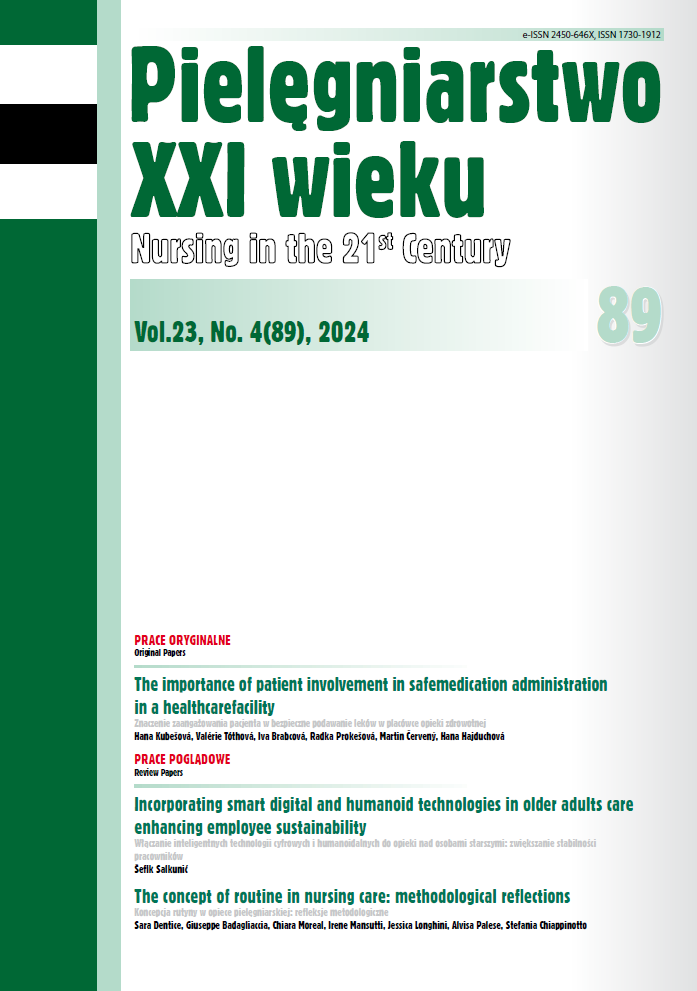What makes labor difficult? Predictors and features of difficult labor in women’s and midwives’ perspective
DOI:
https://doi.org/10.2478/pielxxiw-2024-0038Keywords:
difficult labor, midwives’ experience, women’s experience, intrapartum careAbstract
WHAT MAKES LABOR DIFFICULT? PREDICTORS AND FEATURES OF DIFFICULT LABOR IN WOMEN’S AND MIDWIVES’ PERSPECTIVE
Aim. The aim of this study was to identify what are the features of ‘difficult labor’ in the perspective of women giving birth and midwives providing care.
Material and methods. Cross-section, preliminary study based on the analysis of the labor observation form and level of labor difficulty assessment form designed for the purpose of this study and filled in by the midwives participating in the study.
The participants were 31 midwives working on the labor unit in one of the hospitals in Warsaw, Poland and 152 women who gave birth.
Results. Women who had epidural, larger babies and a negative attitude towards birth and a prolonged first stage of labor, were more likely to assess their labor as difficult. Among midwives labors with a longer second stage, abnormal uterine contraction patterns, and prolonged latent phase and first stage of labor were assessed as more difficult.
Conclusions. Some labors, despite being classified as physiological, require more effort on the part of both the midwife and woman giving birth and end with a higher level of fatigue for both. Predictors of difficult labor should be used by healthcare personnel as a guidance to help identify women at risk of negative labor experiences.
References
1. World Health Organization. WHO recommendations Intrapartum care for a positive childbirth experience. [Internet]. 2018. Available from: https://apps.who.int/iris/bitstream/handle/10665/260178/9789241550215-eng.pdf
2. Shorey S, Yang YY, Ang E. The impact of negative childbirth experience on future reproductive decisions: A quantitative systematic review. J. Adv. Nurs. 2018;74(6):1236-1244.
3. Baranowska B. The Quality of Childbirth in The Light of Research the New Guidelines of The World Health Organization and Polish Perinatal Care Standards. Dev. Period. Med. 2019;23(1):54-59.
4. Olza I, Leahy-Warren P, Benyamini Y, et al. Women’s psychological experiences of physiological childbirth: a meta-synthesis. BMJ Open. 2018;8(10):e020347.
5. Ford E, Ayers S. Support during birth interacts with prior trauma and birth intervention to predict postnatal post-traumatic stress symptoms. Psychol. Health. 2011;26(12):1553-1570.
6. Dewi IS, Anggraini H, Silaban TDS. Relationship between Mal Presentation, Contractions and Baby Weight with Prolonged Parturition in the Teluk Lubuk Health Center Working Area in 2020. Sci. Midwifery. 2022;10(2):574-579.
7. Arya SB, Sharma A, Goel JK, et al. Study of the Feto-maternal Outcome in Occipito-posterior Position at the Onset of Labor. SRMS J. Med. Sci. 2017;2(02):61-65.
8. O’Riordan N, Robson M, McAuliffe FM. Management of poor progress in labour. Obstet. Gynaecol. Reprod. Med. 2021;31(12):342-350.
9. Ängeby K, Sandin-Bojö AK, Persenius M, et al. Women’s labour experiences and quality of care in relation to a prolonged latent phase of labour. Midwifery. 2019;77:155-164.
10. Kempe P, Vikström-Bolin M. Women’s satisfaction with the birthing experience in relation to duration of labour, obstetric interventions and mode of birth. Eur J Obstet Gynecol. Reprod. Biol. 2020;246:156-159.
11. Edqvist M, Rådestad I, Lundgren I, et al. Practices used by midwives during the second stage of labor to facilitate birth – Are they related to perineal trauma? Sex Reprod. Healthc. 2018;15:18-22.
12. Simkin P, Hanson L, Ancheta R. The Labor Progress Handbook: Early Interventions to Prevent and Treat Dystocia. John Wiley & Sons; 2017, p. 418.
13. Carlsson IM, Ziegert K, Sahlberg-Blom E, et al. Maintaining power: Women’s experiences from labour onset before admittance to maternity ward. Midwifery. 2012;28(1):86-92.
14. Sánchez-Cunqueiro MJ, Comeche MI, Docampo D. On the relation of self-efficacy and coping with the experience of childbirth. J. Nurs. Educ. Pract. 2018;8(6):48.
15. Witkiewicz M, Baranowska B, Romanowska M. Standard organizacji opieki okołoporodowej w warunkach pozaszpitalnych. [in:] Iwanowicz-Palus G, Bień A, editors. Techniki położnicze i prowadzenie porodu. Warszawa: PZWL; 2022.
16. Blanc J, Castel P, Mauviel F, et al. Prophylactic manual rotation of occiput posterior and transverse positions to decrease operative delivery: the PROPOP randomized clinical trial. Am. J. Obstet. Gynecol. 2021;225(4):444.e1-444.e8.
17. Mercier RJ, Kwan M. Impact of peanut ball device on the duration of active labor:
A randomized control trial. Am. J. Perinatol. 2018;35(10):1006-1011.
18. Pinar SE, Demirel G. The effect of therapeutic touch on labour pain, anxiety and childbirth attitude: A randomized controlled trial. Eur. J. Integr. Med. 2021;41:101255.
19. Hajizadeh K, Vaezi M, Meedya S, et al. Respectful maternity care and its relationship with childbirth experience in Iranian women: a prospective cohort study. BMC Pregnancy Childbirth. 2020;20(1):468.
20. Høgh S, Navne LE, Johansen M, et al. Postnatal consultations with an obstetrician after critical perinatal events: a qualitative study of what women and their partners experi-ence. BMJ Open. 2020;10(9):e037933.
Downloads
Published
Issue
Section
License
Copyright (c) 2024 Authors

This work is licensed under a Creative Commons Attribution 4.0 International License.




